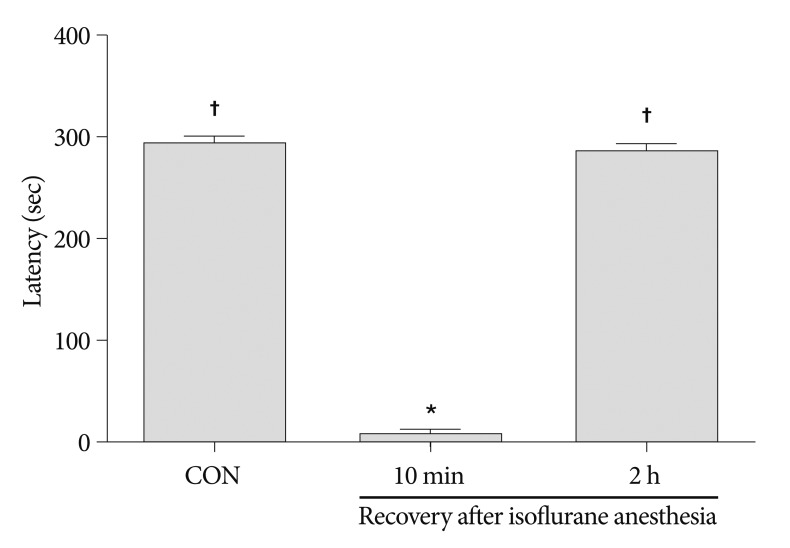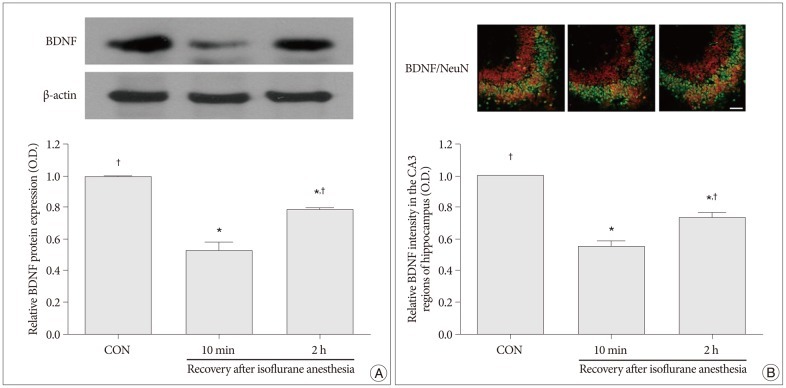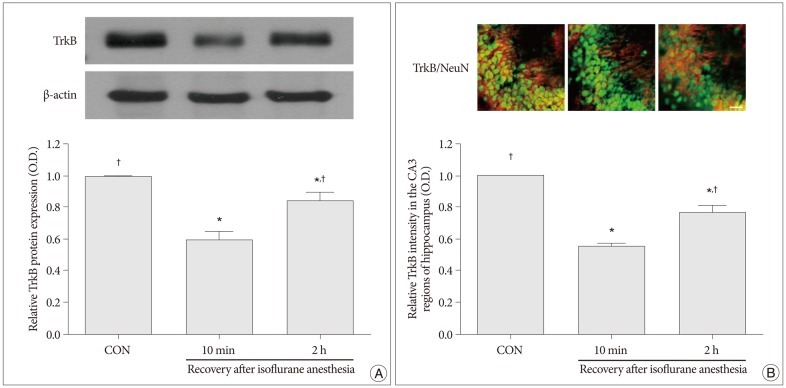1. Alonso M, Vianna MR, Depino AM, Mello e Souza T, Pereira P, Szapiro G, et al. BDNF-triggered events in the rat hippocampus are required for both short- and long-term memory formation. Hippocampus. 2002; 12:551–560. PMID:
12201640.

2. Arancio O, Chao MV. Neurotrophins, synaptic plasticity and dementia. Curr Opin Neurobiol. 2007; 17:325–330. PMID:
17419049.

3. Bartsch T, Schönfeld R, Müller FJ, Alfke K, Leplow B, Aldenhoff J, et al. Focal lesions of human hippocampal CA1 neurons in transient global amnesia impair place memory. Science. 2010; 328:1412–1415. PMID:
20538952.

4. Bliss TV, Collingridge GL. A synaptic model of memory : long-term potentiation in the hippocampus. Nature. 1993; 361:31–39. PMID:
8421494.

5. Bortolon RJ, Weglinski MR, Sprung J. Transient global amnesia after general anesthesia. Anesth Analg. 2005; 101:916–919. PMID:
16116014.

6. Cunha C, Brambilla R, Thomas KL. A simple role for BDNF in learning and memory? Front Mol Neurosci. 2010; 3:1. PMID:
20162032.

7. Dutton RC, Maurer AJ, Sonner JM, Fanselow MS, Laster MJ, Eger EI 2nd. Isoflurane causes anterograde but not retrograde amnesia for pavlovian fear conditioning. Anesthesiology. 2002; 96:1223–1229. PMID:
11981164.

8. Jia F, Pignataro L, Harrison NL. GABAA receptors in the thalamus : alpha4 subunit expression and alcohol sensitivity. Alcohol. 2007; 41:177–185. PMID:
17521848.

9. Kesner RP, Goodrich-Hunsaker NJ. Developing an animal model of human amnesia : the role of the hippocampus. Neuropsychologia. 2010; 48:2290–2302. PMID:
19883669.

10. Kim H, Lee SH, Kim SS, Yoo JH, Kim CJ. The influence of maternal treadmill running during pregnancy on short-term memory and hippocampal cell survival in rat pups. Int J Dev Neurosci. 2007; 25:243–249. PMID:
17434282.

11. Kim SE, Ko IG, Kim BK, Shin MS, Cho S, Kim CJ, et al. Treadmill exercise prevents aging-induced failure of memory through an increase in neurogenesis and suppression of apoptosis in rat hippocampus. Exp Gerontol. 2010; 45:357–365. PMID:
20156544.

12. Kohara K, Kitamura A, Morishima M, Tsumoto T. Activity-dependent transfer of brain-derived neurotrophic factor to postsynaptic neurons. Science. 2001; 291:2419–2423. PMID:
11264540.

13. Koponen E, Võikar V, Riekki R, Saarelainen T, Rauramaa T, Rauvala H, et al. Transgenic mice overexpressing the full-length neurotrophin receptor trkB exhibit increased activation of the trkB-PLCgamma pathway, reduced anxiety, and facilitated learning. Mol Cell Neurosci. 2004; 26:166–181. PMID:
15121188.

14. Lee E, Son H. Adult hippocampal neurogenesis and related neurotrophic factors. BMB Rep. 2009; 42:239–244. PMID:
19470236.

15. Lu LX, Yon JH, Carter LB, Jevtovic-Todorovic V. General anesthesia activates BDNF-dependent neuroapoptosis in the developing rat brain. Apoptosis. 2006; 11:1603–1615. PMID:
16738805.

16. Lu Y, Christian K, Lu B. BDNF : a key regulator for protein synthesis-dependent LTP and long-term memory? Neurobiol Learn Mem. 2008; 89:312–323. PMID:
17942328.

17. Ma YL, Wang HL, Wu HC, Wei CL, Lee EH. Brain-derived neurotrophic factor antisense oligonucleotide impairs memory retention and inhibits long-term potentiation in rats. Neuroscience. 1998; 82:957–967. PMID:
9466420.

18. Martin SJ, Grimwood PD, Morris RG. Synaptic plasticity and memory : an evaluation of the hypothesis. Annu Rev Neurosci. 2000; 23:649–711. PMID:
10845078.
19. Minichiello L, Korte M, Wolfer D, Kühn R, Unsicker K, Cestari V, et al. Essential role for TrkB receptors in hippocampus-mediated learning. Neuron. 1999; 24:401–414. PMID:
10571233.

20. Mizuno M, Yamada K, Olariu A, Nawa H, Nabeshima T. Involvement of brain-derived neurotrophic factor in spatial memory formation and maintenance in a radial arm maze test in rats. J Neurosci. 2000; 20:7116–7121. PMID:
10995859.

21. Mu JS, Li WP, Yao ZB, Zhou XF. Deprivation of endogenous brain-derived neurotrophic factor results in impairment of spatial learning and memory in adult rats. Brain Res. 1999; 835:259–265. PMID:
10415381.

22. Munte S, Schmidt M, Meyer M, Nager W, Lüllwitz E, Münte TF, et al. Implicit memory for words played during isoflurane- or propofol-based anesthesia : the lexical decision task. Anesthesiology. 2002; 96:588–594. PMID:
11873032.
23. Murer MG, Yan Q, Raisman-Vozari R. Brain-derived neurotrophic factor in the control human brain, and in Alzheimer's disease and Parkinson's disease. Prog Neurobiol. 2001; 63:71–124. PMID:
11040419.

24. Perouansky M, Rau V, Ford T, Oh SI, Perkins M, Eger EI 2nd, et al. Slowing of the hippocampal θ rhythm correlates with anesthetic-induced amnesia. Anesthesiology. 2010; 113:1299–1309. PMID:
21042201.

25. Pietropaolo S, Paterna JC, Büeler H, Feldon J, Yee BK. Bidirectional changes in water-maze learning following recombinant adenovirus-associated viral vector (rAAV)-mediated brain-derived neurotrophic factor expression in the rat hippocampus. Behav Pharmacol. 2007; 18:533–547. PMID:
17762522.

26. Rau V, Iyer SV, Oh I, Chandra D, Harrison N, Eger EI 2nd, et al. Gamma-aminobutyric acid type A receptor alpha 4 subunit knockout mice are resistant to the amnestic effect of isoflurane. Anesth Analg. 2009; 109:1816–1822. PMID:
19923508.

27. Saarelainen T, Pussinen R, Koponen E, Alhonen L, Wong G, Sirviö J, et al. Transgenic mice overexpressing truncated trkB neurotrophin receptors in neurons have impaired long-term spatial memory but normal hippocampal LTP. Synapse. 2000; 38:102–104. PMID:
10941145.

28. Schinder AF, Poo M. The neurotrophin hypothesis for synaptic plasticity. Trends Neurosci. 2000; 23:639–645. PMID:
11137155.

29. Shekhar R. Transient global amnesia--a review. Int J Clin Pract. 2008; 62:939–942. PMID:
18248396.
30. Sung YH, Shin MS, Cho S, Baik HH, Jin BK, Chang HK, et al. Depression-like state in maternal rats induced by repeated separation of pups is accompanied by a decrease of cell proliferation and an increase of apoptosis in the hippocampus. Neurosci Lett. 2010; 470:86–90. PMID:
20043974.

31. Twersky RS, Hartung J, Berger BJ, McClain J, Beaton C. Midazolam enhances anterograde but not retrograde amnesia in pediatric patients. Anesthesiology. 1993; 78:51–55. PMID:
8424571.

32. Wade JG, Stevens WC. Isoflurane: an anesthetic for the eighties? Anesth Analg. 1981; 60:666–682. PMID:
7023281.
33. Waterhouse EG, Xu B. New insights into the role of brain-derived neurotrophic factor in synaptic plasticity. Mol Cell Neurosci. 2009; 42:81–89. PMID:
19577647.

34. Werner DF, Swihart A, Rau V, Jia F, Borghese CM, McCracken ML, et al. Inhaled anesthetic responses of recombinant receptors and knockin mice harboring α2(S270H/L277A) GABA(A) receptor subunits that are resistant to isoflurane. J Pharmacol Exp Ther. 2011; 336:134–144. PMID:
20807777.

35. Yu Q, Wang H, Chen J, Gao Y, Liang W. Neuroprotections and mechanisms of inhalational anesthetics against brain ischemia. Front Biosci (Elite Ed). 2010; 2:1275–1298. PMID:
20515801.







 PDF
PDF ePub
ePub Citation
Citation Print
Print


 XML Download
XML Download